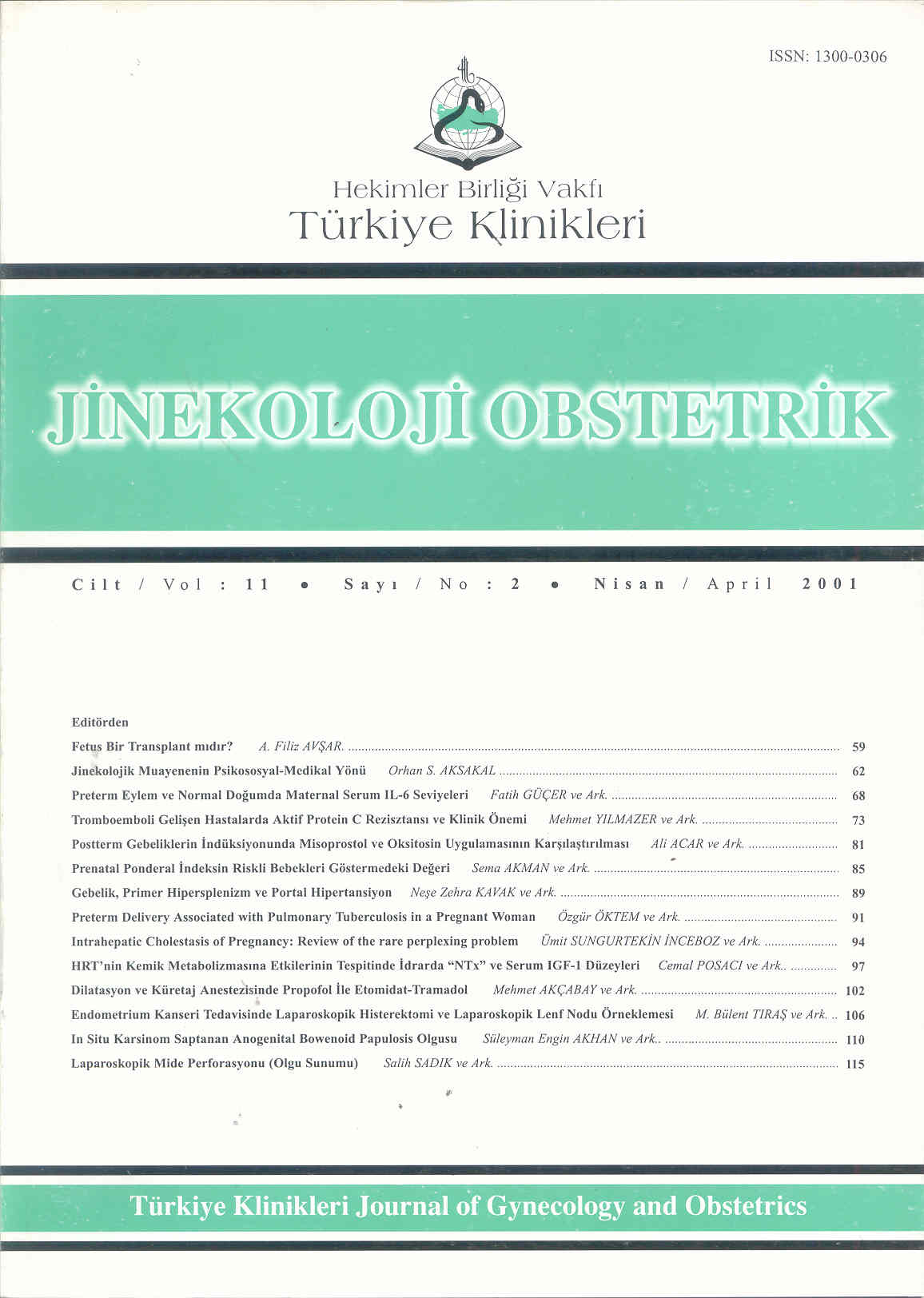Open Access
Peer Reviewed
ARTICLES
3130 Viewed3496 Downloaded
To Compare Misoprostol With Oxytocine Infusion For Inductionof Postterm Pregnancy
Postterm Gebeliklerin İndüksiyonunda Misoprostol ve Oksitosin Uygulamasının Karşılaştırılması
Turkiye Klinikleri J Gynecol Obst. 2001;11(2):81-4
Article Language: TR
Copyright Ⓒ 2025 by Türkiye Klinikleri. This is an open access article under the CC BY-NC-ND license (http://creativecommons.org/licenses/by-nc-nd/4.0/)
ÖZET
Amaç: Postterm gebeliklerde doğum indüksiyonunda vajinal misoprostol uygulamasının, oksitosin infüzyonu ile karşılaştırılması. Materyel ve Metod: Selçuk Üniversitesi Tıp fakültesi Kadın Hastalıkları ve Doğum ABD na başvuran 223 postterm gebe çalışmaya alındı. Randomize olarak 106 gebeye oksitosin infüzyonu uygulanırken, 117 gebeye de vajinal olarak 25 mg misoprostol uygulandı. Vajinal arka fornikse misoprostol uygulanan grupta; servikal olgunlaşma ve aktif doğum eylemi başlamayan olgulara 3 saat sonra tekrar 25 mg 2. bir doz vajinal misoprostol uygulandı. Bulgular: Oksitosin grubunda yaş ortalaması 21.3±3.4 (16-45) iken, misoprostol grubunda ise 19.2±6.7 (16-41) idi. İki grup arasında yaş bakımından istatistiki farklılık saptanmadı (P>0.05). Her iki grup arasında parite bakımından istatistiki farklılık saptanmadı (P>0.05). Tedavinin başlangıcı ile doğum gerçekleşene kadarki süre misoprostol ve oksitosin uygulanan gruplarda sırası ile 690.7±347.2 ve 817.4±512.1 dakika olarak saptandı. Misoprostol uygulanan grupta doğum eylemi gerçekleşene kadar geçen süre oksitosin uygulanan gruptan yaklaşık olarak 120 dakika daha kısaydı. Her iki grup arasında doğum eylemi gelişene kadarki geçen süre bakımından istatistiki farklılık saptandı (p<0.05). Vajinal doğum misoprostol grubunda 102 (%87.2) olguda görülürken, oksitosin grubunda 78 (%73.6) olguda görüldü ve iki grup arasında istatistiki farklılık saptandı (p<0.05). Yeni doğanın 1. ve 5. dakika Apgar skorları bakımından iki grup arasında istatistiki farklılık saptanmadı (p<0.05). Takisistol ve şiddetli bulantı misoprostol grubunda daha sık olarak saptandı. Sonuç: Doğum indüksiyonunda vajinal olarak uygulanan misoprostol, oksitosine karşı güçlü bir alternatiftir.
Amaç: Postterm gebeliklerde doğum indüksiyonunda vajinal misoprostol uygulamasının, oksitosin infüzyonu ile karşılaştırılması. Materyel ve Metod: Selçuk Üniversitesi Tıp fakültesi Kadın Hastalıkları ve Doğum ABD na başvuran 223 postterm gebe çalışmaya alındı. Randomize olarak 106 gebeye oksitosin infüzyonu uygulanırken, 117 gebeye de vajinal olarak 25 mg misoprostol uygulandı. Vajinal arka fornikse misoprostol uygulanan grupta; servikal olgunlaşma ve aktif doğum eylemi başlamayan olgulara 3 saat sonra tekrar 25 mg 2. bir doz vajinal misoprostol uygulandı. Bulgular: Oksitosin grubunda yaş ortalaması 21.3±3.4 (16-45) iken, misoprostol grubunda ise 19.2±6.7 (16-41) idi. İki grup arasında yaş bakımından istatistiki farklılık saptanmadı (P>0.05). Her iki grup arasında parite bakımından istatistiki farklılık saptanmadı (P>0.05). Tedavinin başlangıcı ile doğum gerçekleşene kadarki süre misoprostol ve oksitosin uygulanan gruplarda sırası ile 690.7±347.2 ve 817.4±512.1 dakika olarak saptandı. Misoprostol uygulanan grupta doğum eylemi gerçekleşene kadar geçen süre oksitosin uygulanan gruptan yaklaşık olarak 120 dakika daha kısaydı. Her iki grup arasında doğum eylemi gelişene kadarki geçen süre bakımından istatistiki farklılık saptandı (p<0.05). Vajinal doğum misoprostol grubunda 102 (%87.2) olguda görülürken, oksitosin grubunda 78 (%73.6) olguda görüldü ve iki grup arasında istatistiki farklılık saptandı (p<0.05). Yeni doğanın 1. ve 5. dakika Apgar skorları bakımından iki grup arasında istatistiki farklılık saptanmadı (p<0.05). Takisistol ve şiddetli bulantı misoprostol grubunda daha sık olarak saptandı. Sonuç: Doğum indüksiyonunda vajinal olarak uygulanan misoprostol, oksitosine karşı güçlü bir alternatiftir.
ANAHTAR KELİMELER: Doğum indüksiyonu, postterm gebelik, misoprostol, oksitosin
ABSTRACT
Objective: To compare vaginally administered misoprostol with intravenous oxytocin for labor indüction in women with postterm pregnancy. Material and Methods: 223 postterm pregnant whose applied Selçuk University Medicine Faculty Department of Obstetrics and Gynecology were included the study. As randomly, 106 pregnant were administered intravenous oxytocin and 117 pregnant were administered vaginally 25 mg misoprostol. In the group of administered misoprostol placed the posterior vaginal fornix, the patients who had not begun active labor and cervical ripering were repeated a single dose intravaginal misoprostol 3 hours later. Result: Mean of age oxytocin and misoprostol groups was 21.3±3.4 (16-45) and 19.2±6.7 (16-41), respectively. In these two groups, there werent statistical difference about age (P>0.05). Respect of parity, there were not statistical difference between two group. The average intervals from start of the therapy to vaginal delivery between misoprostol and oxytocin groups were 690.7±347.2 and 817.4±512.1 minutes. This interval was about 120 minutes shorter in the misoprostol group than oxytocin group. There were statistical significant this interval between two group (P<0.05). 102 (87.2%) vaginal delivery occured in misoprostol group and 78 (73,6 %) oxytocin group and there was statistical significance between two group (P<0.05). Significant differences were not found 1 or 5 minute Apgar scores (p<0.05). Tachysystole and severe nausing in the misoprostol group is more than the oxytocin group. Conclusion: Vaginal administration of misoprostol is an effective alternative to oxytocin infusion for labor induction.
Objective: To compare vaginally administered misoprostol with intravenous oxytocin for labor indüction in women with postterm pregnancy. Material and Methods: 223 postterm pregnant whose applied Selçuk University Medicine Faculty Department of Obstetrics and Gynecology were included the study. As randomly, 106 pregnant were administered intravenous oxytocin and 117 pregnant were administered vaginally 25 mg misoprostol. In the group of administered misoprostol placed the posterior vaginal fornix, the patients who had not begun active labor and cervical ripering were repeated a single dose intravaginal misoprostol 3 hours later. Result: Mean of age oxytocin and misoprostol groups was 21.3±3.4 (16-45) and 19.2±6.7 (16-41), respectively. In these two groups, there werent statistical difference about age (P>0.05). Respect of parity, there were not statistical difference between two group. The average intervals from start of the therapy to vaginal delivery between misoprostol and oxytocin groups were 690.7±347.2 and 817.4±512.1 minutes. This interval was about 120 minutes shorter in the misoprostol group than oxytocin group. There were statistical significant this interval between two group (P<0.05). 102 (87.2%) vaginal delivery occured in misoprostol group and 78 (73,6 %) oxytocin group and there was statistical significance between two group (P<0.05). Significant differences were not found 1 or 5 minute Apgar scores (p<0.05). Tachysystole and severe nausing in the misoprostol group is more than the oxytocin group. Conclusion: Vaginal administration of misoprostol is an effective alternative to oxytocin infusion for labor induction.
MENU
POPULAR ARTICLES
MOST DOWNLOADED ARTICLES





This journal is licensed under a Creative Commons Attribution-NonCommercial-NoDerivatives 4.0 International License.










